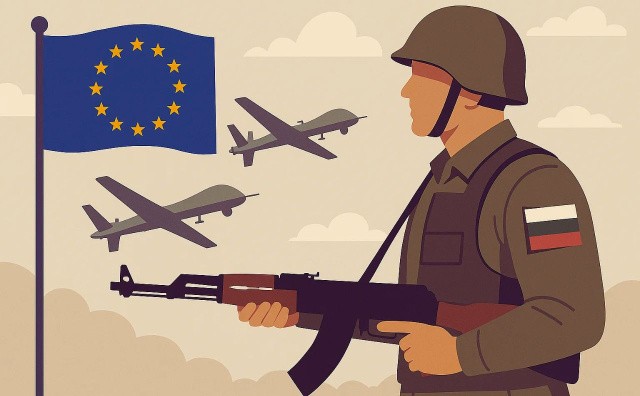Right now, Europe faces an unprecedented security challenge as Russian drone incursions into NATO and EU airspace have become increasingly frequent and brazen. The response: EU has launched an ambitious ” Drone Wall” initiative that places Bulgaria at the center of a continental defense network stretching from Finland to the Black Sea.
The urgency became undeniable after a series of provocative incidents in September 2025. Nineteen Russian drones violated Polish airspace on September 10, followed by similar incursions into Romania and Estonia. Danish airports were forced to shut down for hours due to unidentified drone activity, while Estonian airspace was breached by Russian MiG-31 fighter jets. These incidents revealed a worrying reality: traditional NATO defense systems, designed for conventional warfare, are inadequate against cheap drone swarms that cost thousands of dollars but require million-dollar missiles to intercept.
Bulgaria’s Position in the Defense Architecture
Bulgaria emerged as a key participant in the high-level video conference of defense ministers held on September 26, 2025, joining Estonia, Finland, Latvia, Lithuania, Poland, and Romania in discussions about the Eastern Flank Watch initiative. Defense Minister Atanas Zapryanov confirmed Bulgaria’s commitment to the project, emphasizing the nation’s unique strategic position on the EU’s southeastern border.
The Bulgarian government has specifically insisted on building critical capabilities to ensure security in the Black Sea as part of the common drone protection system. This maritime focus distinguishes Bulgaria’s contribution from its Baltic counterparts, who concentrate primarily on land-based threats. Minister Zapryanov stressed that Bulgaria would participate “with the means we have and with new ones that we need to acquire,” indicating both current capabilities and future procurement needs.
Bulgaria’s geographic position makes it a crucial link in the defensive chain. As reserve colonel Ivan Milanov noted, the country must prepare to defend against threats from “all directions” – not just the traditional eastern approach but also maritime routes through the Black Sea and potential southern vectors.
Technical Challenges and Current Limitations
Bulgarian experts have been candid about the country’s current preparedness gaps. Ivan Milanov, vice president of the International Association for Combating Drones, acknowledged that “we are still at the theoretical stage” and “we are not ready yet.” The challenge extends beyond military preparations to include coordination with civilian infrastructure, requiring collaboration between the Ministry of Defense, Ministry of Transport, and Ministry of Civil Protection.
Bulgaria currently relies on MiG-29 and F-16 aircraft for air defense, but as Milanov pointed out, “this is completely insufficient” for comprehensive drone defense. The country faces the same cost-effectiveness dilemma plaguing NATO: using expensive fighter jets and missiles against cheap drones creates an unsustainable economic equation. A surface drone incident near Varna in September required deployment of a helicopter, boat, and ship – illustrating the resource-intensive nature of current countermeasures.
The technical complexity of drone defense involves multiple phases: detection, identification, trajectory assessment, and neutralization decision-making – all within extremely compressed timeframes. Bulgarian systems must evolve to distinguish between threatening drones and harmless decoys, a capability that only Ukraine and Russia have developed through years of combat experience.
The Broader Defense Framework
The Drone Wall represents one pillar of the comprehensive Eastern Flank Watch initiative, complemented by ground defenses and maritime security measures. European Commissioner for Defense Andrius Kubilius emphasized that the system would serve “all of Europe,” not just frontline states, through advanced detection, tracking, and interception capabilities coordinated by a single center.
Bulgaria’s participation involves multiple technological components: electronic warfare systems to jam drone signals, physical barriers like protective meshes over critical infrastructure, mobile installations with heavy machine guns, and advanced sensors including acoustic systems that can detect drones through sound signatures. The acoustic sensor technology is particularly relevant for Bulgaria, as traditional radars struggle to detect small drone signatures.
Former Defense Minister Angel Naydenov highlighted Bulgaria’s potential to benefit from emerging technologies, noting that “some countries are already developing laser weapons” for drone defense, citing Israel’s “Iron Beam” system as an example. This suggests opportunities for Bulgarian defense industry participation in next-generation countermeasures.
Economic and Industrial Opportunities
The drone wall initiative presents significant economic opportunities for Bulgarian manufacturers. MEP Andrey Novakov confirmed that “Bulgaria can benefit in specific cases, because I know of Bulgarian manufacturers who also create anti-drone systems that can defeat and neutralize foreign drones and produce drones that can patrol much cheaper and much safer.” This indicates existing domestic capabilities that could be scaled up for the European project.

